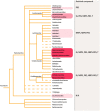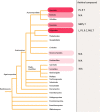Antiviral Agents From Fungi: Diversity, Mechanisms and Potential Applications
- PMID: 30333807
- PMCID: PMC6176074
- DOI: 10.3389/fmicb.2018.02325
Antiviral Agents From Fungi: Diversity, Mechanisms and Potential Applications
Abstract
Viral infections are amongst the most common diseases affecting people worldwide. New viruses emerge all the time and presently we have limited number of vaccines and only few antivirals to combat viral diseases. Fungi represent a vast source of bioactive molecules, which could potentially be used as antivirals in the future. Here, we have summarized the current knowledge of fungi as producers of antiviral compounds and discuss their potential applications. In particular, we have investigated how the antiviral action has been assessed and what is known about the molecular mechanisms and actual targets. Furthermore, we highlight the importance of accurate fungal species identification on antiviral and other natural products studies.
Keywords: antiviral agents; antiviral mechanisms; endophytes; fungal secondary metabolites; medicinal mushrooms; natural products.
Figures




Similar articles
-
Endophytic Fungi as a Source of Antiviral Compounds - A Review.Chem Biodivers. 2022 Jun;19(6):e202100971. doi: 10.1002/cbdv.202100971. Epub 2022 Apr 28. Chem Biodivers. 2022. PMID: 35426966 Review.
-
Recent Advances in the Discovery of Antiviral Metabolites from Fungi.Curr Pharm Biotechnol. 2022;23(4):495-537. doi: 10.2174/1389201022666210615120720. Curr Pharm Biotechnol. 2022. PMID: 34132180 Review.
-
Fungal endophytes as prolific source of phytochemicals and other bioactive natural products: A review.Microb Pathog. 2015 May;82:50-9. doi: 10.1016/j.micpath.2015.04.001. Epub 2015 Apr 9. Microb Pathog. 2015. PMID: 25865953 Review.
-
Fungal Endophytes: Microfactories of Novel Bioactive Compounds with Therapeutic Interventions; A Comprehensive Review on the Biotechnological Developments in the Field of Fungal Endophytic Biology over the Last Decade.Biomolecules. 2023 Jun 25;13(7):1038. doi: 10.3390/biom13071038. Biomolecules. 2023. PMID: 37509074 Free PMC article. Review.
-
Bioactive molecules from fungal endophytes and their applications in pharmaceutical industries: challenges and future scope.J Basic Microbiol. 2023 Jul;63(7):690-708. doi: 10.1002/jobm.202200696. Epub 2023 Mar 30. J Basic Microbiol. 2023. PMID: 36998101 Review.
Cited by
-
Epigenetic Activation of Silent Biosynthetic Gene Clusters in Endophytic Fungi Using Small Molecular Modifiers.Front Microbiol. 2022 Feb 14;13:815008. doi: 10.3389/fmicb.2022.815008. eCollection 2022. Front Microbiol. 2022. PMID: 35237247 Free PMC article. Review.
-
Antiviral PROTACs: Opportunity borne with challenge.Cell Insight. 2023 Mar 27;2(3):100092. doi: 10.1016/j.cellin.2023.100092. eCollection 2023 Jun. Cell Insight. 2023. PMID: 37398636 Free PMC article. Review.
-
Willow (Salix spp.) bark hot water extracts inhibit both enveloped and non-enveloped viruses: study on its anti-coronavirus and anti-enterovirus activities.Front Microbiol. 2023 Nov 8;14:1249794. doi: 10.3389/fmicb.2023.1249794. eCollection 2023. Front Microbiol. 2023. PMID: 38029113 Free PMC article.
-
Anti-HIV-1 reverse transcriptase property of some edible mushrooms in Asia.Saudi J Biol Sci. 2021 May;28(5):2807-2815. doi: 10.1016/j.sjbs.2021.02.012. Epub 2021 Feb 16. Saudi J Biol Sci. 2021. PMID: 34012322 Free PMC article.
-
Mushrooms as future generation healthy foods.Front Nutr. 2022 Dec 6;9:1050099. doi: 10.3389/fnut.2022.1050099. eCollection 2022. Front Nutr. 2022. PMID: 36562045 Free PMC article. Review.
References
-
- Amoros M., Boustie J., Py M.-L., Hervé V., Robin V. (1997). Antiviral activity of homobasidiomycetes: evaluation of 121 basidiomycetes extracts on four viruses. Int. J. Pharmacogn. 35 255–260. 10.1076/phbi.35.4.255.13308 - DOI
-
- Amzat J., Razum O. (eds). (2018). “Traditional medicine in Africa,” in Towards a Sociology of Health Discourse in Africa, (Cham: Springer). 10.1007/978-3-319-61672-8 - DOI
-
- Baker D., Mocek U., Garr C. (2000). “Natural products vs. combinatorials: a case study,” in Biodiversity: New Leads for Pharmaceutical and Agrochemical Industries eds Wrigley S. K., Hayes M. A., Thomas R., Chrystal E. J. T., Nicholson N. (Cambridge: The Royal Society of Chemistry; ) 66–72.
Publication types
LinkOut - more resources
Full Text Sources

